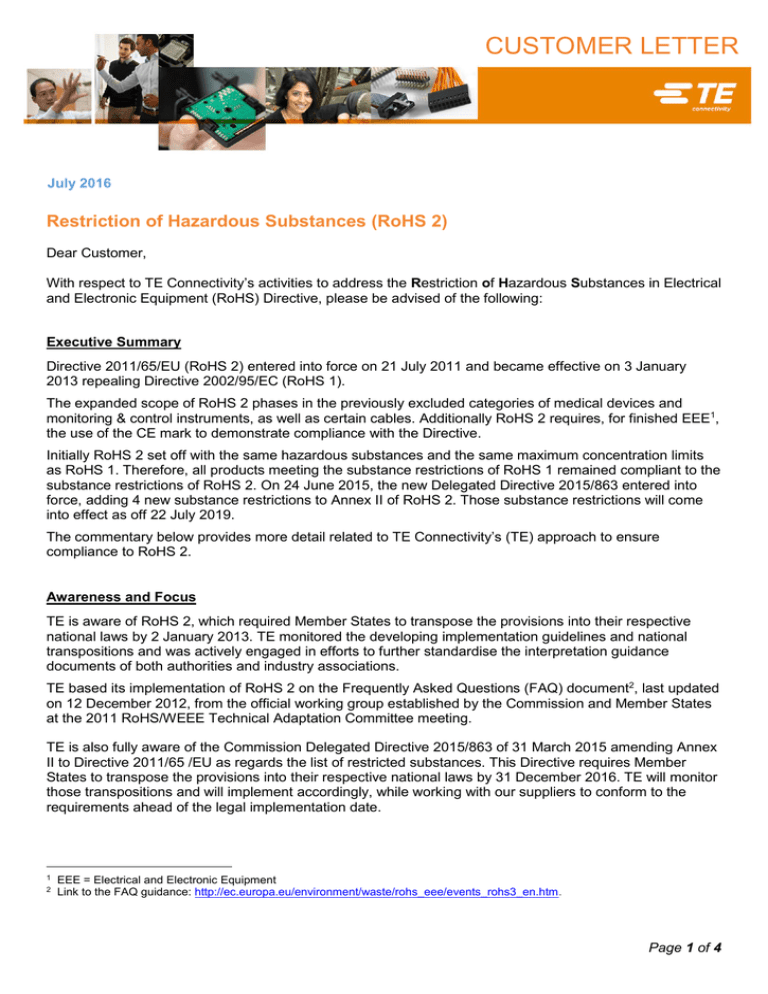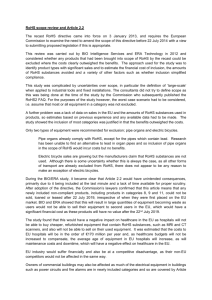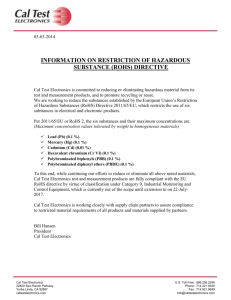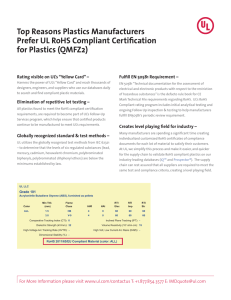RoHS 2 Statement - TE Connectivity
advertisement

CUSTOMER LETTER July 2016 Restriction of Hazardous Substances (RoHS 2) Dear Customer, With respect to TE Connectivity’s activities to address the Restriction of Hazardous Substances in Electrical and Electronic Equipment (RoHS) Directive, please be advised of the following: Executive Summary Directive 2011/65/EU (RoHS 2) entered into force on 21 July 2011 and became effective on 3 January 2013 repealing Directive 2002/95/EC (RoHS 1). The expanded scope of RoHS 2 phases in the previously excluded categories of medical devices and monitoring & control instruments, as well as certain cables. Additionally RoHS 2 requires, for finished EEE1, the use of the CE mark to demonstrate compliance with the Directive. Initially RoHS 2 set off with the same hazardous substances and the same maximum concentration limits as RoHS 1. Therefore, all products meeting the substance restrictions of RoHS 1 remained compliant to the substance restrictions of RoHS 2. On 24 June 2015, the new Delegated Directive 2015/863 entered into force, adding 4 new substance restrictions to Annex II of RoHS 2. Those substance restrictions will come into effect as off 22 July 2019. The commentary below provides more detail related to TE Connectivity’s (TE) approach to ensure compliance to RoHS 2. Awareness and Focus TE is aware of RoHS 2, which required Member States to transpose the provisions into their respective national laws by 2 January 2013. TE monitored the developing implementation guidelines and national transpositions and was actively engaged in efforts to further standardise the interpretation guidance documents of both authorities and industry associations. TE based its implementation of RoHS 2 on the Frequently Asked Questions (FAQ) document2, last updated on 12 December 2012, from the official working group established by the Commission and Member States at the 2011 RoHS/WEEE Technical Adaptation Committee meeting. TE is also fully aware of the Commission Delegated Directive 2015/863 of 31 March 2015 amending Annex II to Directive 2011/65 /EU as regards the list of restricted substances. This Directive requires Member States to transpose the provisions into their respective national laws by 31 December 2016. TE will monitor those transpositions and will implement accordingly, while working with our suppliers to conform to the requirements ahead of the legal implementation date. 1 2 EEE = Electrical and Electronic Equipment Link to the FAQ guidance: http://ec.europa.eu/environment/waste/rohs_eee/events_rohs3_en.htm. Page 1 of 4 CUSTOMER LETTER Substance Restrictions Until 21 July 2019 RoHS2 will deal with the same six hazardous substances and the same maximum concentration limits as RoHS 1: lead (0.1%), mercury (0.1%), cadmium (0.01%), hexavalent chromium (0.1%), polybrominated biphenyls [PBB] (0.1%) and polybrominated diphenyl ethers [PBDE] (0.1%). As of 22 July 2019 four new hazardous substances: Bis(2-ethylhexyl)phthalate (DEHP) (0.1%), Butyl benzyl phthalate (BBP) (0.1%), Dibutyl phthalate (DBP) (0.1%), Diisobutyl phthalate (DIBP) (0.1%) come into effect for EEE. For medical devices and monitoring & control instruments those new substance restrictions will be applicable as of 22 July 2021.TE plans to begin to capture supplier data related to the new substances in early 2017. By mid-2017 it is the intention to update the part specific Statement of Compliance (SoC) with the supplier data if available, to indicate whether these substances are present above the maximum allowed concentration limit. Our Check Product Compliance Tool provides the actual compliance status of any TE product with respect to RoHS, as well as REACH and halogen content, and the option to download part specific Statement of Compliance (SoC). Expansion of Scope RoHS 2 expands the scope of products covered by phasing in EEE categories 8 (medical devices) and 9 (monitoring and control instruments) which were previously excluded under RoHS 1. The expanded RoHS 2 scope also includes certain cable assemblies used to connect EEE or to provide power to EEE. Per the RoHS 2 FAQ version of 12 December 2012, the following cable assembly types are considered to be ‘out of scope’: optical cables, cables internal to EEE (this includes cables permanently attached to EEE), and cables with a rated voltage greater than or equal to 250 volts. For most cable assemblies, the timeline for being in scope is related to the timeline of the EEE with which they are used. Bulk cable only becomes in scope as of 2019. Note that the majority of TE’s cable products already comply with the substance restrictions as a result of our efforts under RoHS 1. TE bulk cable sold to assembly houses will be compliant with the substance restrictions of RoHS 2, confirmed in our Statements of Compliance, but will not contain any RoHS compliance marking as TE does not know the compliance status of our customers’ finished product. The RoHS 2 Directive does not apply to non-electric tools, large-scale fixed installations, or to electrical and electronics equipment designed for use with a voltage rating exceeding 1000 volts AC or 1500 volts DC. Exemptions at Risk for Expiration in 2016 Due to the maximum validity rules for exemptions introduced in RoHS 2, 54 exemptions are at risk for expiration in July 2016 if no renewal is granted. Applications for renewal had to be submitted before 22 January 2015. For 46 exemptions a renewal application dossier was submitted. TE is monitoring the status of those renewal dossiers, especially those on exemptions 6(a), 6(b), 6(c), 7(a), 7(c)-I and 8(b) that are the most routinely used by TE products. A final decision of the European Commission is not expected before mid2016. Page 2 of 4 CUSTOMER LETTER Of the 8 exemptions without a renewal application dossier (5(a), 7(b), 17, 25, 30, 31, 33 and 38), only 2 are used by TE and the use of exemptions 5(a) and 7(b) in our products is being phased out. Parts still claiming those exemptions on 21 July 2016 will be recoded as non-compliant. CE Marking In contrast to RoHS 1, RoHS 2 is a CE marking Directive, and requires, for finished EEE, the use of the CE mark on the product to show compliance. The responsibility for affixing the CE mark resides with the manufacturer. For finished EEE where TE is the legal manufacturer, TE will affix the CE mark. For finished EEE that TE produces for OEMs, the CE mark can, similar to other customer specifications, be affixed by TE on the customers’ behalf without TE assuming the OEM’s (manufacturer’s) responsibility (see section on technical documentation). Please be advised that CE marking for RoHS 2 only applies to finished EEE in scope of RoHS 2. The use of the CE mark is not allowed on products not in scope of an EU Directive, and can therefore not be applied to TE component products (such as connectors, terminals, switches, relays, sensors, etc.). Declaration of Conformity (DoC) and Technical Documentation In addition to placing the CE mark on all finished EEE in scope of RoHS 2, all CE marked EEE will require a Declaration of Conformity (DoC) and associated technical documentation. The responsibility for this DoC and documentation resides with the manufacturer. For finished EEE where TE is the legal manufacturer, TE will provide the DoC and prepare technical documentation per Harmonised European Standard EN50581. For finished EEE that TE produces for OEMs, it is only the OEM that can fulfil the obligations to provide the required documentation under its own name. Communication of Compliance Status of TE Parts TE provides a Statement of Compliance (SoC) for all sellable parts. These SoCs reflect TE’s declared level of conformity to the major global compliance initiatives (RoHS, ELV, REACH, China RoHS and Halogen content). The available SoCs can be consulted on our website at http://www.te.com/globalen/utilities/product-compliance.html. TE has an ongoing effort to make material declarations available for our products in the IPC-1752A format. Considering TE's breadth of portfolio, this is quite an undertaking and these documents will not be available for all parts for some time. Page 3 of 4 CUSTOMER LETTER For additional information regarding TE Connectivity’s Product Compliance initiatives and to access the Check Product Compliance Tool, please visit our Product Compliance Support Center at http://www.te.com/global-en/utilities/product-compliance.html. Guy Degrieck Product Environmental Compliance TE Connectivity Page 4 of 4



